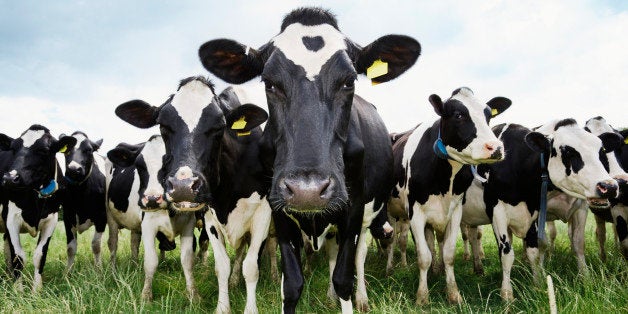
President Obama recently likened denying climate change to believing the moon is made of cheese. As it turns out, ignoring this particular food's role in climate change is just as irresponsible. Getting serious about climate change would mean finally addressing the gorilla - or, more appropriately, the cow -- in the room. If you really care about the environment, you'd leave the cheese -- and all meat and dairy products for that matter -- off your plate.
By some estimates, the meat and dairy industry is responsible for up to half of all human-caused greenhouse gas emissions -- contributing more to climate change than even coal-fired power plants. Trying to regulate climate change without touching the meat industry is like trying to curb the obesity crisis without confronting, well, the meat industry.
I learned about the vast environmental destruction caused by meat and dairy production while growing up in the Midwest. My family raised cattle, and all around our town were fields of corn and soybeans as far as the eye could see. These fields were not planted for people. They were planted to feed pigs, cattle, and chickens.
Why so much corn and soybeans? Because it takes almost three pounds of feed to produce a pound of chicken or turkey. It takes 7 to 13 pounds of feed to produce a pound of beef. In fact, animals consume two-thirds of the calories produced per acre of land in the United States -- that's enough food to feed one billion humans.
Cows are ruminants, meaning that microbes in a cow's rumen or "fore-stomach" ferment whatever the animal has been eating, creating methane, which is belched into the air. Cattle raised for beef or dairy products are prolific methane producers.
Were there just an occasional cow around, no one would care. But if the 100 million cattle living in the United States at any given time all stood on a scale simultaneously, their collective weight would far exceed that of the U.S. human population. And every last one is belching out methane, a greenhouse gas that is 21 times more powerful than carbon dioxide at trapping heat.
So as weather patterns become more and more chaotic, blame the burgers, steaks, ribs, sausage, and other products of the massively overpopulated cows across the globe. Sure, cracking down on coal may be part of the fix. But there is a long-term solution to climate change that everyone can do right now: get the animals off our plates.
So, that's the bad news. The good news is that when people eat grains, beans, and other plant foods directly, instead of feeding them to animals, we need much less acreage and less energy, and we end up with a dramatically cleaner--and cooler--environment. Instead of turning corn and beans into chickens, pigs, and cows, we can make corn into corn bread, tortillas, stews, soups, or polenta and turn beans into chili, burritos, veggie burgers, or soymilk. We can turn grains, vegetables, fruits, and legumes into a spaghetti dinner, an Asian stir-fry, or ten thousand other meals. And we can toast our environmental stewardship, as the Earth breathes easier.